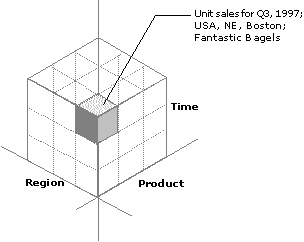
In an OLAP data model, information is viewed conceptually as cubes that consist of descriptive categories (dimensions) and quantitative values (measures). The multidimensional data model makes it easy for users to formulate complex queries, arrange data on a report, switch from summary to detail data, and filter or slice data into meaningful subsets. For example, typical dimensions in a cube containing sales information include time, geography, product, channel, organization, and scenario (budget or actual). Typical measures include dollar sales, unit sales, inventory, headcount, income, and expense.

Within each dimension of an OLAP data model, data can be organized into a hierarchy that represents levels of detail on the data. For example, within the time dimension, you may have the levels years, months, and days; similarly, within the geography dimension, you may have the levels country, region, state/province, and city. A particular instance of the OLAP data model would have the specific values for each level in the hierarchy. A user viewing OLAP data can move up or down between levels to view information that is either more or less detailed.